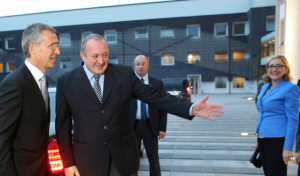Will Jens Stoltenberg’s Visit to Georgia Have Any Grand Implications?
NATO Secretary General Jens Stoltenberg arrived in the Georgian capital for a two-day official visit on August 26.
Foreign Minister of Georgia, Tamar Beruchashvili, and Head of NATO Liaison Office, William Lahue, greeted the high-ranking official of the Alliance at Tbilisi International Airport. It is known that Stoltenberg’s visit, besides meeting with some high governmental officials and policy makers, was mainly dedicated to opening the NATO Training Center at the Krtsanisi Military Base.
Giorgi Margvelashvili, Georgian President hosted Stoltenberg at the Presidential Palace. Reportedly, the two assessed the achieved progress of Georgia on its path to integration in the alliance. The Georgian President, with the NATO delegation, discussed some regional security issues and Georgia’s occupied territories, including the ongoing so-called borderization process by Russia.
The Secretary General paid tribute to the soldiers fallen for Georgia’s freedom and laid a wreath at the Memorial of Heroes.
For the main event during the visit, the NATO-Georgia Joint Training and Assessment Center was opened in Krtsanisi on August 27. The Secretary General also met with the soldiers of the armed forces who had been trained for NATO’s Rapid Response Forces (RRF).
“NATO Secretary General Jens Stoltenberg’s visit is a clear demonstration of NATO’s support for Georgia,” Tamar Beruchashvili told media.
The Minister emphasized that the visit is the continuation of a high-level political dialogue, which has been intensive in recent years.
“The visit is very important and is a clear demonstration of the fact that Georgia is a significant part of the alliance’s agenda. It is very important for NATO to get familiar with the ongoing processes in the region, including Georgia’s reforms,” Beruchashvili maintained.
Analysis by Georgia Today’s Zviad Adzinbaia:
This is the first time Jens Stoltenberg has visited Georgia as NATO Secretary General. The visit and the opening of the Training Center are of high importance and reflects support towards Georgia. At the same time, Georgia, which has successfully implemented an array of reforms throughout the past decade, is expecting more than words this time as the security situation in the region has worsened due to Russian aggression.
Looking back to the Bucharest Summit of 2008, Georgia, after what Ron Asmus called a ‘Diplomatic Shootout’, was promised its eventual membership in the alliance, a decision which was followed by full-scale Russian military aggression in Georgia to destroy the progress achieved by the country.
In addition, current developments in Ukraine have lucidly demonstrated that if a security umbrella of the west does not cover Georgia, she will probably be a dessert cake for Russia. It is widely believed that NATO can even be enlarged without granting a Membership Action Plan (MAP), which is considered a roadmap for the alliance. As Georgia has implemented diverse packages, including the Annual National Programs (ANP), it is time for the alliance to make some tangible and daring decisions.
Will Stoltenberg’s visit change the picture and prepare Georgia for better news at the forthcoming NATO Warsaw Summit next year?
Zviad Adzinbaia












